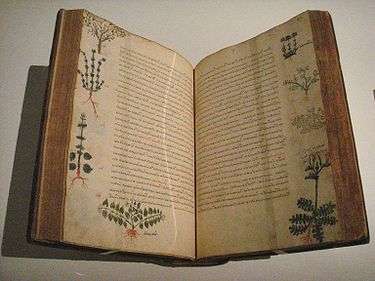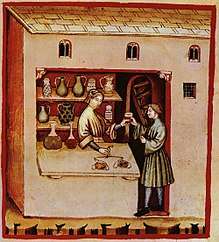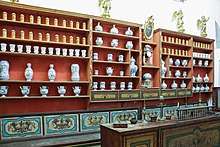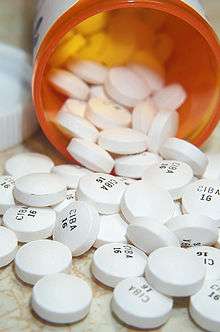History of pharmacy
The history of pharmacy as an independent science dates back to the first third of the 19th century. Before then, pharmacy evolved from antiquity as part of medicine. The history of pharmacy coincides well with the history of medicine, but it's important that there is a distinction between the two topics. Pharmaceuticals is one of the most-researched fields in the academic industry, but the history surrounding that particular topic is sparse compared to the impact its made world-wide. Before the advent of pharmacists, there existed apothecaries that worked alongside priests and physicians in regard to patient care.
%2C_Pharmacy_--_2013_--_3519.jpg)
Prehistoric Pharmacy
Paleopharmacological studies attest to the use of medicinal plants in pre-history.[1] For example, herbs were discovered in the Shanidar Cave, and remains of the areca nut (Areca catechu) in the Spirit Cave.[2]:8 Prehistoric man learned pharmaceutical techniques through instinct, by watching birds and beasts, and using cool water, leaves, dirt, or mud as a soothing agent.[3]
Antiquity
Mesopotamia
Sumerian cuneiform tablets record prescriptions for medicine.[4] Ancient Egyptian pharmacological knowledge was recorded in various papyri such as the Ebers Papyrus of 1550 BC and it included a 1,100 page document about 800 prescriptions using 700 drugs mostly derived from plants[5], and the Edwin Smith Papyrus of the 16th century BC.
The very beginnings or pharmaceutical texts were written on clay tablets by Mesopotamians. Some texts included formulas, instructions via pulverization, infusion, boiling, filtering and spreading; herbs were mentioned as well.[6] Babylon, a state within Mesopotamia, provided the earliest known practice of running an apothecary i.e. pharmacy. Alongside the ill person included a priest, physician, and a pharmacist to tend to their needs.[3]
Greece

In Ancient Greece, there existed a separation between physician and herbalist. The duties of the herbalist was to supply physicians with raw materials, including plants, to make medicines[7]. According to Edward Kremers and Glenn Sonnedecker, "before, during and after the time of Hippocrates there was a group of experts in medicinal plants. Probably the most important representative of these rhizotomoi was Diocles of Carystus (4th century BC). He is considered to be the source for all Greek pharmacotherapeutic treatises between the time of Theophrastus and Dioscorides."[8]
From 60 and 78 AD,[2]:21–22 the Greek physician Pedanius Dioscorides wrote a five volume book, De Materia Medica, covering over 600 plants and coining the term materia medica. It formed the basis for many medieval texts, and was built upon by many middle eastern scientists during the Islamic Golden Age.[2]:21–22
Asia
The earliest known Chinese manual on materia medica is the Shennong Bencao Jing (The Divine Farmer's Herb-Root Classic), dating back to the 1st century AD. It was compiled during the Han dynasty and was attributed to the mythical Shennong. Earlier literature included lists of prescriptions for specific ailments, exemplified by a manuscript "Recipes for 52 Ailments", found in the Mawangdui, sealed in 168 BC. Further details on Chinese pharmacy can be found in the Pharmacy in China article.
The earliest known compilation of medicinal substances in Indian traditional medicine dates to the 3rd or 4th century AD )(attributed to Sushruta, who is recorded as a physician of the 6th century BC).
There is a stone sign for a pharmacy with a tripod, a mortar, and a pestle opposite one for a doctor in the Arcadian Way in Ephesus, Turkey.
In Japan, at the end of the Asuka period (538-710) and the early Nara period (710-794), the men who fulfilled roles similar to those of modern pharmacists were highly respected. The place of pharmacists in society was expressly defined in the Taihō Code (701) and re-stated in the Yōrō Code (718). Ranked positions in the pre-Heian Imperial court were established; and this organizational structure remained largely intact until the Meiji Restoration (1868). In this highly stable hierarchy, the pharmacists—and even pharmacist assistants—were assigned status superior to all others in health-related fields such as physicians and acupuncturists. In the Imperial household, the pharmacist was even ranked above the two personal physicians of the Emperor.[9]
Middle Ages
Middle East
In Baghdad the first pharmacies, or drug stores, were established in 754,[10] under the Abbasid Caliphate during the Islamic Golden Age. By the 9th century, these pharmacies were state-regulated.[11]

The advances made in the Middle East in botany and chemistry led medicine in medieval Islam substantially to develop pharmacology. Muhammad ibn Zakarīya Rāzi (Rhazes) (865-915), for instance, acted to promote the medical uses of chemical compounds. Abu al-Qasim al-Zahrawi (Abulcasis) (936-1013) pioneered the preparation of medicines by sublimation and distillation. His Liber servitoris is of particular interest, as it provides the reader with recipes and explains how to prepare the "simples" from which were compounded the complex drugs then generally used. Sabur Ibn Sahl (d 869), was, however, the first physician to initiate pharmacopoedia, describing a large variety of drugs and remedies for ailments. Al-Biruni (973-1050) wrote one of the most valuable Islamic works on pharmacology entitled Kitab al-Saydalah (The Book of Drugs), where he gave detailed knowledge of the properties of drugs and outlined the role of pharmacy and the functions and duties of the pharmacist. Ibn Sina (Avicenna), too, described no less than 700 preparations, their properties, mode of action and their indications. He devoted in fact a whole volume to simple drugs in The Canon of Medicine. Of great impact were also the works by al-Maridini of Baghdad and Cairo, and Ibn al-Wafid (1008–1074), both of which were printed in Latin more than fifty times, appearing as De Medicinis universalibus et particularibus by `Mesue' the younger, and the Medicamentis Simplicibus by `Abenguefit'. Peter of Abano (1250–1316) translated and added a supplement to the work of al-Maridini under the title De Veneris. Al-Muwaffaq's contributions in the field are also pioneering. Living in the 10th century, he wrote The Foundations of the True Properties of Remedies, amongst others describing arsenious oxide, and being acquainted with silicic acid. He made clear distinction between sodium carbonate and potassium carbonate, and drew attention to the poisonous nature of copper compounds, especially copper vitriol, and also lead compounds. He also describes the distillation of sea-water for drinking.[12]

Europe

After the 5th century fall of the Western Roman Empire, medicinal knowledge in Europe suffered due to the loss of Greek medicinal texts and a strict adherence to tradition, although an area of Southern Italy near Salerno remained under Byzantine control and developed a hospital and medical school, which became famous by the 11th century.[2]:30
In the early 11th century, Salerno scholar Constantinos Africanus translated many Arabic books into Latin, driving a shift from Hippocratic medicine towards a pharmaceutical-driven approach advocated by Galen.[2]:30 In medieval Europe, monks typically did not speak Greek, leaving only Latin texts such as the works of Pliny available until these translations by Constantinos.[2]:30 In addition, Arabic medicine became more widely known due to Muslim Spain.[2]:30
In the 15th century, the printing press spread medicinal textbooks and formularies; the Antidotarium was the first printed drug formulary.[2]:30
In Europe pharmacy-like shops began to appear during the 12th century. In 1240 emperor Frederic II issued a decree by which the physician's and the apothecary's professions were separated.[5]
Old pharmacies continue to operate in Dubrovnik, Croatia located inside the Franciscan monastery, opened in 1317. The Town Hall Pharmacy in Tallinn, Estonia, which dates back to at least 1422, is the oldest continuously run pharmacy in the world still operating in the original premises.[13]
The trend towards pharmacy specialization started to take effect in Bruges, Belgium where a new law was passed that forbid physicians to prepare medications for patients.[14]
The oldest pharmacy is claimed to be set up in 1221 in the Church of Santa Maria Novella in Florence, Italy, which now houses a perfume museum. The medieval Esteve Pharmacy, located in Llívia, a Catalan enclave close to Puigcerdà, is also now a museum dating back to the 15th century, keeping albarellos from the 16th and 17th centuries, old prescription books and antique drugs. Florence is also the birthplace of the first official pharmacopeia, called the Nuevo Receptario, in which all pharmacies would use that document as guidance for caring for the sickly.[3]
The Republic of Venice was the first State with health modern policies which requires that the nature of the drug is public. In actuality, thirteen secrets survive which were offered to sale to the Venetian Republic.[15]
Industrialization
The 1800s brought increased technical sophistication. By the late 1880s, German dye manufacturers had perfected the purification of individual organic compounds from tar and other mineral sources and had also established rudimentary methods in organic chemical synthesis.[16]

Chloral hydrate was introduced as a sleeping aid and sedative in 1869.[17] Chloroform was first used as an anesthetic in 1847.[18]
Derivatives of phenothiazines had an important impact on various aspects of medicine, beginning with methylene blue which was originally used as a dye after its synthesis from aniline in 1876.[19] Phenothiazines were used as antimalarials, antiseptics, and antihelminthics up to 1940.[20] 1950, chlorpromazine was discovered, which began the "psychopharmacological revolution".[20]
The United States formed the American Pharmaceutical Association in 1852[21] with its main purpose to advance pharmacists' roles in patient care, assist in furthering career development, spread information about tools and resources, and raising awareness about the roles of pharmacists and their contribution to patient care. [22]
Frederick Banting and Charles Best showed through dogs that the hormone Insulin lowered their blood sugar and started the catalyst that James B. Collip finished. Collip developed pure insulin used for human testing and dramatically changed the prospects for all diabetics.
Alexander Fleming developed the first antibiotic, penicillin, after discovering a fungus that was able to kill off bacteria. [23]
See also
References
- Ellis, Linda (2000). Archaeological Method and Theory: An Encyclopedia. Taylor & Francis. pp. 443–448. ISBN 978-0-8153-1305-2.
- Sneader, Walter (2005-10-31). Drug Discovery: A History. John Wiley & Sons. ISBN 9780470015520.
- Bender, George (1965). "Great Moments in Pharmacy" (PDF). Pharmacy at Auburn. Retrieved 26 July 2020.
- John K. Borchardt (2002). "The Beginnings of Drug Therapy: Ancient Mesopotamian Medicine". Drug News & Perspectives. 15 (3): 187–192. doi:10.1358/dnp.2002.15.3.840015. ISSN 0214-0934. PMID 12677263.
- "History of Pharmacy Web Pages - Sweden´s oldest pharmacies". Archived from the original on 2011-06-23. Retrieved 2011-04-27.
- "Becoming a Pharmacist & History of Pharmacy | Pharmacy is Right for Me". Pharmacy for me. Retrieved 2020-07-27.
- "Pharmacy". Encyclopedia Britannica. Retrieved 2020-07-27.
- Edward Kremers, Glenn Sonnedecker (1986). "Kremers and Urdang's History of pharmacy". Amer. Inst. History of Pharmacy. p.17. ISBN 0-931292-17-4
- Titsingh, Isaac. (1834) Annales des empereurs du japon, p. 434.
- Hadzovic, S (1997). "Pharmacy and the great contribution of Arab-Islamic science to its development". Medicinski Arhiv (in Croatian). 51 (1–2): 47–50. ISSN 0025-8083. OCLC 32564530. PMID 9324574.
- al-Ghazal, Sharif Kaf (October 2003). "The valuable contributions of Al-Razi (Rhazes) in the history of pharmacy during the Middle Ages" (PDF). Journal of the International Society for the History of Islamic Medicine. 2 (4): 9–11. ISSN 1303-667X. OCLC 54045642.
- Levey M. (1973), Early Arabic Pharmacology, E. J. Brill; Leiden.
- "Ain Raal: apteegist maakeeli." Postimees 3. March 2020.
- "Pharmacy". Encyclopedia Britannica. Retrieved 2020-07-27.
- Stevens Crawshaw, Jane (2014). "Families, medical secrets and public health in early modern Venice". Renaissance Studies. 28 (4): 597–618. doi:10.1111/rest.12081.
- "Top Pharmaceuticals: Introduction: EMERGENCE OF PHARMACEUTICAL SCIENCE AND INDUSTRY: 1870-1930".
- Jones, Alan Wayne (2011-06-01). "Early drug discovery and the rise of pharmaceutical chemistry". Drug Testing and Analysis. 3 (6): 337–344. doi:10.1002/dta.301. ISSN 1942-7611. PMID 21698778.
- Dingwall (April 2004). "A pioneering history: dentistry and the Royal College of Surgeons of Edinburgh" (PDF). historyofdentistry.co.uk. Archived from the original (PDF) on 1 February 2013.
- Humans, IARC Working Group on the Evaluation of Carcinogenic Risk to (2016). Exposure Data. International Agency for Research on Cancer.
- López-Muñoz, Francisco; Alamo, Cecilio; Cuenca, Eduardo; Shen, Winston W.; Clervoy, Patrick; Rubio, Gabriel (2005-07-01). "History of the discovery and clinical introduction of chlorpromazine". Annals of Clinical Psychiatry. 17 (3): 113–135. doi:10.1080/10401230591002002. ISSN 1040-1237. PMID 16433053.
- "Pharmacy - Research". Encyclopedia Britannica. Retrieved 2020-07-25.
- "APhA Vision, Mission, Value Statements". www.pharmacist.com. Retrieved 2020-07-25.
- The pharmacy technician. American Pharmacists Association. (Sixth edition ed.). Englewood Cliffs, N.J.: Perspective Press/Morton Pub. Co. 2016. ISBN 978-1-61731-487-2. OCLC 981462588.CS1 maint: others (link) CS1 maint: extra text (link)
External links

